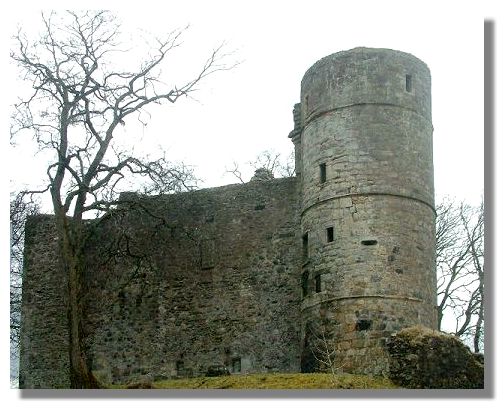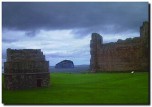
Scottish Castles Photo Library
- Strathaven Castle, South Lanarkshire

The town of Strathaven (pronounced "Stray-ven) in South Lanarkshire, gets its name from the Gaelic for Avondale, or the valley of the Avon Water, a watercourse half a mile to the south of the town. The castle sits in the centre of the town and is sometimes called Avondale Castle.
Early records, going back to the 14th century, show that the lands in this area was held by the Bairds but they passed to the Sinclairs and then the powerful "Black" Douglases in the early 1400s. When they fell from royal favour, the castle was captured by King James II's forces and the original castle was probably destroyed in 1455. A few years later, the king passed it to a relative, Sir Andrew Stewart, 1st Lord Avondale, an illegitimate grandson of the second Duke of Albany.
Sir Andrew rebuilt the castle, and it is this building which we see today. The 3rd Lord Avondale lost Strathaven Castle to Sir James Hamilton of Finnart, an illegitimate son of the Earl of Arran, in 1534. He had already built nearby Craignethan Castle, the last great defensive castle to be built in Scotland. Sir James was Steward of the Royal Household and Master of Works to King James V, but was accused (without evidence) of plotting against the king and was executed in 1540. Strathaven Castle was subsequently sold to James, 2nd Marquis of Hamilton. The Hamiltons owned the castle for the next 300 years. After the death of Anne, Duchess of Hamilton in 1716, it was abandoned. After the roof blew off in a storm in 1737, the stonework in the castle began to be pilfered by the locals for their own more modest homes.
A tradition, which is perpetuated by a recent plaque outside the castle, suggests that the wife of a past lord so greatly displeased her husband that she was walled up alive in part of Strathaven Castle wall. In the middle of the 19th century, human bones were found within a wall, which had fallen down at that time, giving some credence to this story.
The building was "consolidated" in the 20th century - using a large amount of concrete inside the structure, which is unfortunate.
Return to the Castles Photo Library Index
or go to the next castle:  Tantallon Castle.
Tantallon Castle.
Where else would you like to go in Scotland?
Where else would you like to go in Scotland?

